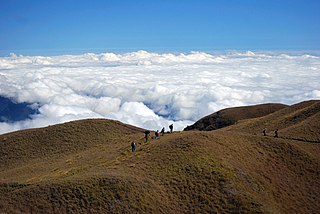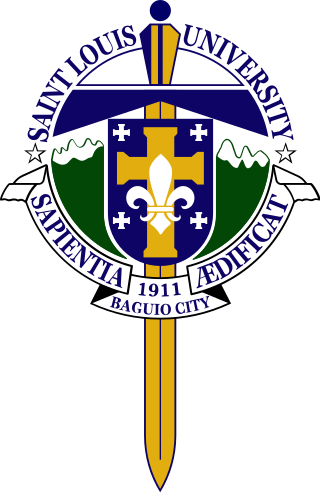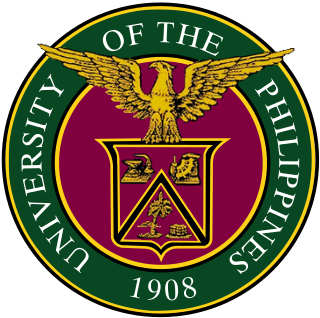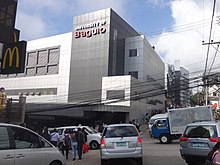
Baguio, officially the City of Baguio, is a 1st class highly urbanized city in the Cordillera Administrative Region, Philippines. It is known as the "Summer Capital of the Philippines", owing to its cool climate since the city is located approximately 4,810 feet above mean sea level, often cited as 1,540 meters in the Luzon tropical pine forests ecoregion, which also makes it conducive for the growth of mossy plants, orchids and pine trees, to which it attributes its other moniker as the "City of Pines".

Benguet, officially the Province of Benguet, is a landlocked province of the Philippines located in the southern tip of the Cordillera Administrative Region in the island of Luzon. Its capital is La Trinidad.

Lyceum of the Philippines University, also referred to by its acronym LPU, is a private, non-sectarian, coeducational higher education institution located at Intramuros in the City of Manila, Philippines. It was founded in 1952 by José P. Laurel, who was the third president of the Republic of the Philippines.

Dagupan, officially the City of Dagupan, is a 1st class independent component city in the Ilocos Region, Philippines. According to the 2020 census, it has a population of 174,302 people.

The Agno River, also known as the Pangasinan River, is a river on the island of Luzon in the Philippines. Traversing the provinces of Benguet, Pangasinan, and Tarlac, it is one of the largest river systems in the country, with a drainage area of 5,952 square kilometres (2,298 sq mi).

Saint Louis University also referred to by its acronym SLU, is a private Catholic research basic and higher education institution run by the Congregation of the Immaculate Heart of Mary in Baguio, Philippines. It was founded on December 1, 1911, by the CICM Missionaries.

The 1990 Luzon earthquake occurred on July 16 at 4:26 p.m. (PDT) or 3:26 p.m. (PST) on the densely populated island of Luzon in the Philippines. The shock had a surface-wave magnitude of 7.8 and produced a 125 km-long ground rupture that stretched from Dingalan, Aurora to Kayapa, Nueva Vizcaya. The event was a result of strike-slip movements along the Philippine Fault and the Digdig Fault within the Philippine Fault System. The earthquake's epicenter was near the town of Rizal, Nueva Ecija, northeast of Cabanatuan. An estimated 1,621 people were killed, most of the fatalities located in Central Luzon and the Cordillera region.
The University of the Cordilleras, formerly known as the Baguio Colleges Foundation (BCF), is a private coeducational university in Baguio, Philippines. Founded by Benjamin R. Salvosa and his wife Evangelina D. Salvosa in 1946, it offers programs at the elementary, secondary, undergraduate and graduate levels catering to around 21,000 students.

The first secondary school in Baguio, Philippines was the normal school in 1916 later called Baguio Trade School. Classes were held where Home Sweet Home now stands as this area and the present University of the Philippines Baguio location was included in the reserved land for the Bureau of Education by Forbes. In 1919 it became Mountain Province High School. Classes were held at Teacher’s Camp and native girls from all over the province were housed at Bua Dormitory known today as Pacdal Elementary School. Among the pioneer teachers were Juan Balagot, Servillano Tumaneng, Pedro Balagot, Genoveva Llamas, Esperanza Ver, Donato Guerzon, Julia Guerzon, Grace H. Miller, Petra Ramirez, and Pilar Tan and Jess L. Gains who was also the principal.

Mount Santo Tomas is a potentially active stratovolcano in the Philippines located in the municipality of Tuba in the province of Benguet. The mountain is part of the protected Santo Tomas Forest Reserve declared through Proclamation No. 581 signed by President Manuel L. Quezon on July 9, 1940.

Metro Baguio, also known as BLISTT, is an agglomeration of the city of Baguio and five municipalities of the Philippine province of Benguet, namely: La Trinidad, Itogon, Sablan, Tuba, and Tublay.

The University of the Philippines Baguio, also referred to as UP in the North or UP Baguio, is a public research university located in Baguio, Philippines. It was established in 1921 through the initiative of UP alumni in Baguio and Benguet and was inaugurated as the University of the Philippines College Baguio on April 22, 1961. It was eventually elevated to its present autonomous status as a constituent university on December 2, 2002.

The University of Baguio Science High School (UBSHS) is a private, nonsectarian science high school. It is the science department of the University of Baguio and was founded in 1963, predating the Philippine Science High School which was established in 1964. The school is considered a pioneer among private science high schools in Asia.

Nesthy Alcayde Petecio is a Filipino amateur boxer. She won a silver medal in the inaugural women's featherweight event at the 2020 Summer Olympics, becoming the first Filipino woman to win an Olympic medal in boxing, and won a bronze medal in the women's flyweight event at the 2024 Summer Olympics. She also won a silver medal at the 2014 World Championships and gold at the 2019 edition.

Baguio General Hospital and Medical Center (BGHMC), also known as Baguio General Hospital (BGH), is a hospital in Baguio, Philippines. It is the largest government funded tertiary hospital in the Northern Luzon Region.

Marquez "Mark" Ocampo Go is a Filipino businessman and politician. A member of the Nacionalista Party, he is the incumbent representative of the legislative district of Baguio since 2016. He is also an outstanding citizen of Baguio awardee in 1998.

Melchor Daguines Diclas is a Filipino politician and physician who has been the governor of Benguet since 2019. A member of Partido Demokratiko Pilipino, Diclas previously served as vice mayor of Buguias from 2007 to 2010, and then as mayor from 2010 to 2016.
Boxing at the 2019 SEA Games in the Philippines was held at the Philippine International Convention Center Forum in Pasay, Metro Manila from 4 to 9 December 2019.
Sena Irie is a Japanese retired amateur boxer who won a gold medal in the inaugural women's featherweight event at the 2020 Summer Olympics. She became the first Japanese woman to win an Olympic gold medal in boxing.

On July 27, 2022, at 8:43:24 a.m. (PHT), an earthquake struck the island of Luzon in the Philippines. The earthquake had a magnitude of 7.0 Mw , with an epicenter in Abra province. Eleven people were reported dead and 615 were injured. At least 35,798 homes, schools and other buildings were damaged or destroyed, resulting in ₱1.88 billion (US$34 million) worth of damage.





















